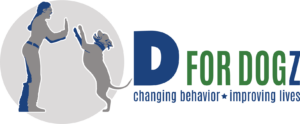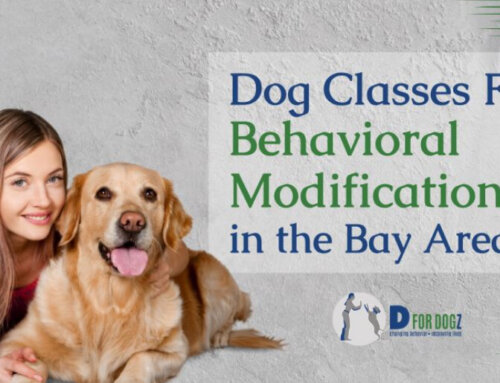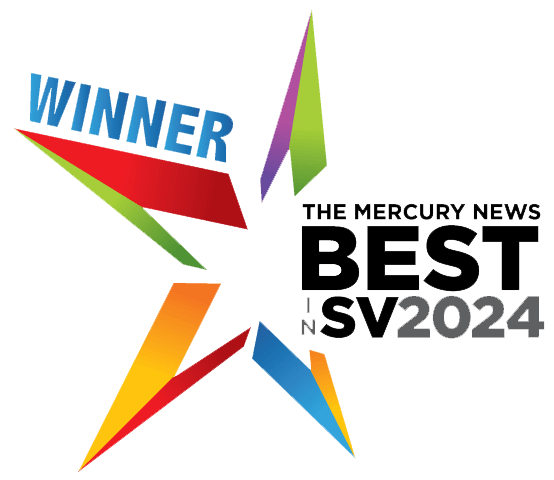A Guide to DIY Puppy Socialization in San Jose
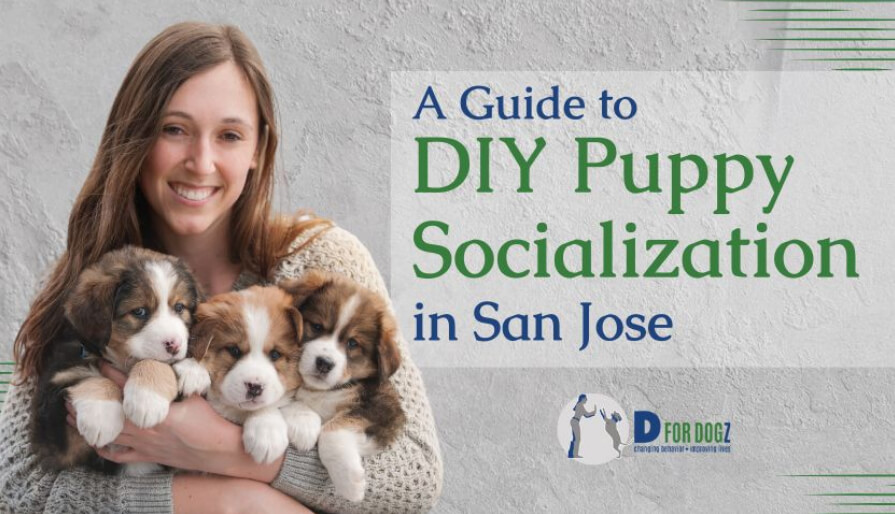
Beginning your puppy’s socialization in San Jose presents an unparalleled opportunity to shape their future. With the city’s rich dog-friendly culture and numerous accessible spaces, engaging in DIY socialization activities is practical and beneficial. This process is vital for helping puppies navigate various settings, sounds, and interactions, setting the stage for their emotional well-being and social adeptness.
Here, we present targeted, manageable approaches for local dog owners to enhance their puppy’s social journey, leveraging the comfort of their homes and the welcoming arms of the San Jose community.
Key Takeaways
- Creating a diverse and safe socialization space at home is fundamental for your puppy’s early exposure to varied stimuli.
- DIY sensory experiences enrich your puppy’s development, fostering adaptability and reducing fearfulness.
- In-home puppy parties and introductions to adult canine friends offer controlled settings for positive social interactions.
- Homemade obstacle courses promote agility and confidence, integrating physical and mental stimulation into your puppy’s routine.
Creating a Safe Socialization Space at Home
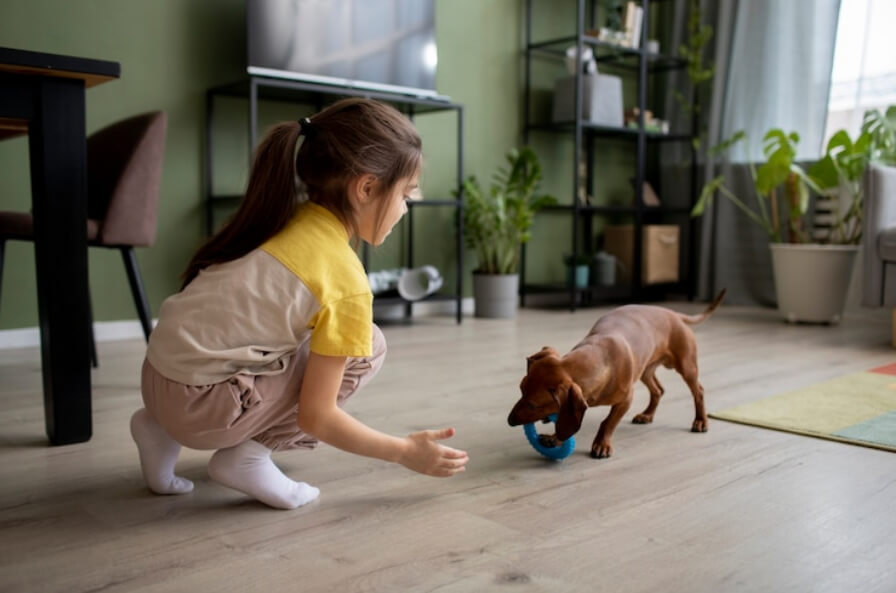
Image Source: Freepik
Creating an effective socialization space at home involves careful planning and consideration. Follow these structured steps to ensure your puppy has a positive learning environment:
1. Choose the Right Location
Identify a quiet, enclosed area in your home away from high foot traffic. This could be a spare room, a corner of your living room, or any space where your puppy feels secure and can explore without distractions.
Ensure the space is easily accessible to family members for regular interaction but can be isolated to control the socialization process if needed.
2. Select Appropriate Items
Gather various household and outdoor items your puppy may encounter. Examples include vacuum cleaners, brooms, boxes, leaves, branches, and stones.
Arrange these items in the space, allowing enough room for your puppy to approach and explore each item voluntarily. Avoid overwhelming the puppy by introducing too many items at once.
3. Introduce Diverse Textures
To familiarize your puppy with various textures, cover the floor with different materials such as carpet, tile, linoleum, and grass mats.
Encourage your puppy to walk on these textures by leading them with treats or toys, ensuring each experience is positive and stress-free.
4. Utilize Positive Reinforcement
Pair exploring new objects and textures with treats, praise, and play. This helps build positive associations and encourages curiosity.
Observe your puppy’s reactions closely and adjust the environment to ensure they remain comfortable and engaged.
5. Regularly Refresh the Environment
As your puppy becomes more accustomed to the initial set of items and textures, gradually introduce new elements to the space. This can include different objects, sounds, or even safe, pet-friendly scents.
This continuous update keeps the environment stimulating and promotes further learning and adaptation.
6. Monitor and Adjust Based on Puppy’s Comfort:
Pay close attention to how your puppy interacts with the socialization space. If they show signs of stress or fear, take a step back and reduce the complexity of the environment.
Always proceed at a pace that aligns with your puppy’s comfort level, and never force interaction with any particular item or texture.
DIY Sensory Experiences

Image Source: Freepik
Creating sensory experiences for your puppy at home is an effective way to simulate the diverse stimuli of outdoor environments in a safe and controlled manner. Utilizing everyday items, you can expose your puppy to a range of textures, sounds, and sights it is likely to encounter daily, enhancing its adaptability and reducing its fearfulness.
- Textures: Use various fabrics and materials to create a sensory path. Lay towels, blankets, aluminum foil, and bubble wrap on the floor for your puppy to walk over. Each material offers a unique feel under their paws, helping them adjust to different textures they might find outside.
- Sounds: Introducing your puppy to various sounds is essential for their auditory development. You can initially use recordings of traffic, other animals, thunderstorms, and fireworks played at a low volume, gradually increasing as they become more comfortable. This can prevent sound phobias from developing. Pairing these sound sessions with treats or playtime can help your puppy form positive associations with these noises.
- Sights: Simulating different visual experiences can also be beneficial. Use moving objects like balloons or remote-controlled toys to mimic animals or vehicles they might see. Introducing your puppy to these elements in a playful, non-threatening way can reduce anxiety about moving objects in the future.
- Smells: While harder to replicate indoors, you can introduce your puppy to different scents by bringing objects from outside, like leaves or flowers, or using safe, pet-friendly scent oils. These olfactory experiences can enrich their sensory development further.
Ensure the puppy’s safety and comfort are the priority in all activities. Observe their reactions closely and proceed at a pace that suits them without forcing interactions. This patient, positive approach to DIY sensory experiences can significantly aid your puppy’s socialization, preparing them for a confident life in the wider world.
In-Home Puppy Parties

Image Source: Freepik
Hosting in-home puppy parties is a fantastic way to enhance your puppy’s socialization in a controlled and safe environment. These gatherings can help your puppy learn to interact positively with various people and even other friendly puppies. Here’s how to organize a successful puppy party:
- Prepare Your Space: Ensure your home is puppy-proofed, with dangerous or fragile items out of reach. Provide a designated puppy area where they can retreat if overwhelmed.
- Guest List: Invite patient friends and family who understand the goal of socializing your puppy. Consider including guests of different ages, sizes, and appearances to accustom your puppy to a variety of people.
- Puppy Guests: If inviting other puppies, ensure they are of similar size and energy level and up to date on vaccinations. A good rule is to have one puppy for every two human guests to avoid overwhelming your pet.
- Safety First: Create a separate area for dog guests to decompress away from the party if needed. Supervise interactions to ensure gentle and positive play.
- Activities and Games: Plan simple, fun activities encouraging gentle interaction, like teaching guests to offer treats for calm behavior or setting up a photo booth with pet-friendly props.
- Positive Reinforcement: Keep plenty of treats on hand to reward good behavior. Encourage guests to use them for positive reinforcement.
Meeting Adult Canine Friends

Image Source: Freepik
Introducing your puppy to well-behaved adult dogs is crucial for their social development. Adult dogs can teach puppies appropriate canine social cues and play behavior.
- Choose the Right Match: Look for adult dogs who are patient and gentle with puppies. The first few interactions should be with dogs that will not overreact to a puppy’s manners (or lack thereof).
- Neutral Territory: Initial meetings should occur in neutral spaces, like a quiet park or a friend’s backyard, to avoid territorial behavior from the adult dog.
- Keep it Short: Initial introductions should be brief and positive. Monitor the body language of both dogs closely for any signs of stress or aggression.
- Supervise Closely: Keep both dogs on a leash and allow them to sniff each other while you hold the leashes loosely. You can allow more free interaction under close supervision if both seem relaxed.
- Gradual Increase in Interaction: If the first meeting goes well, gradually increase their time together, always supervising their interactions to ensure they remain positive.
Exploring Dog-Friendly Public Spaces
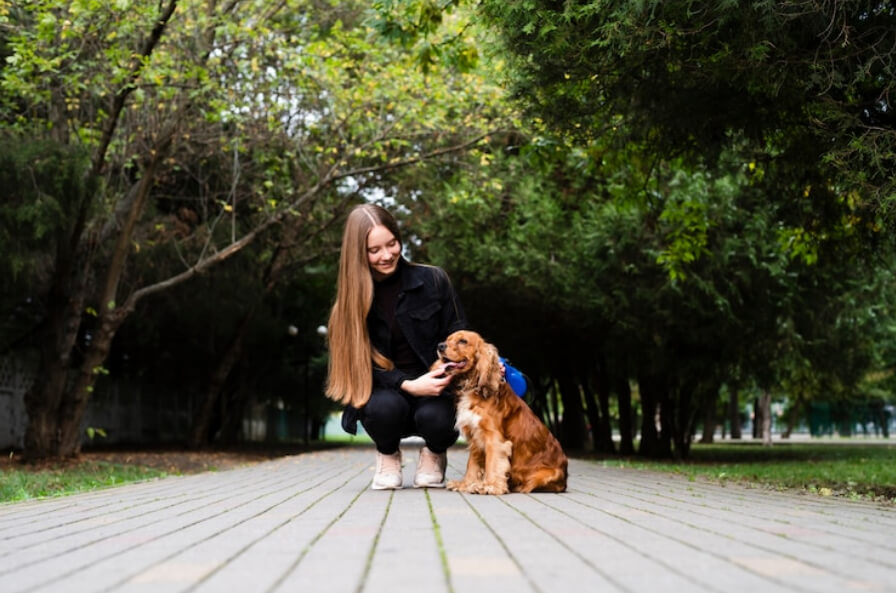
Image Source: Freepik
San Jose and its surroundings offer a variety of dog-friendly spaces perfect for socializing your puppy. These locations can provide new sights, sounds, and smells for your puppy to explore.
- Dog Parks: San Jose has several dog parks where your puppy can interact with other dogs in a safe environment. Before visiting, ensure your puppy is comfortable with other dogs and fully vaccinated.
- Outdoor Cafés and Restaurants: Many establishments welcome dogs in their outdoor seating areas. This can be an excellent way for your puppy to experience new people and environments in a relaxed setting.
- Hiking Trails: The area around San Jose is rich with pet-friendly hiking trails. Trails offer diverse environmental stimuli, from different terrains to various wildlife sounds.
- Pet-Friendly Events: Look out for pet-friendly events like fairs or markets. These events can offer unique socialization opportunities in a bustling environment.
- Safety and Preparation: Bring water, a bowl, and your puppy’s favorite treats. Ensure your puppy is on a leash and monitor their comfort level closely, ready to leave if they seem overwhelmed.
Each of these activities allows your puppy to learn and grow. By gradually introducing them to new experiences, you’ll help them develop into a well-rounded, friendly dog.
Positive Reinforcement at Home

Image Source: Freepik
Positive reinforcement is a powerful tool in shaping your puppy’s behavior and ensuring they view socialization as a positive experience. Here’s how to effectively use it at home:
- Treats and Praise: Use small, tasty treats and enthusiastic praise to reward your puppy for positive behaviors, such as calmly approaching a new person or successfully navigating a new environment.
- Timing is Key: Deliver treats and praise immediately after the desired behavior. This helps your puppy connect the action to the positive outcome.
- Be Consistent: Ensure all family members use the same commands and rewards to avoid confusing your puppy. Consistency across different trainers strengthens learning.
- Balance is Important: While treats are effective, they should be balanced with other forms of reinforcement, like playtime, petting, or verbal praise, to avoid overreliance on food.
- Gradually Phase Out Treats: As your puppy consistently exhibits the desired behavior, gradually reduce the frequency of treats, transitioning to intermittent reinforcement, which can help maintain the behavior in the long term.
Homemade Obstacle Courses
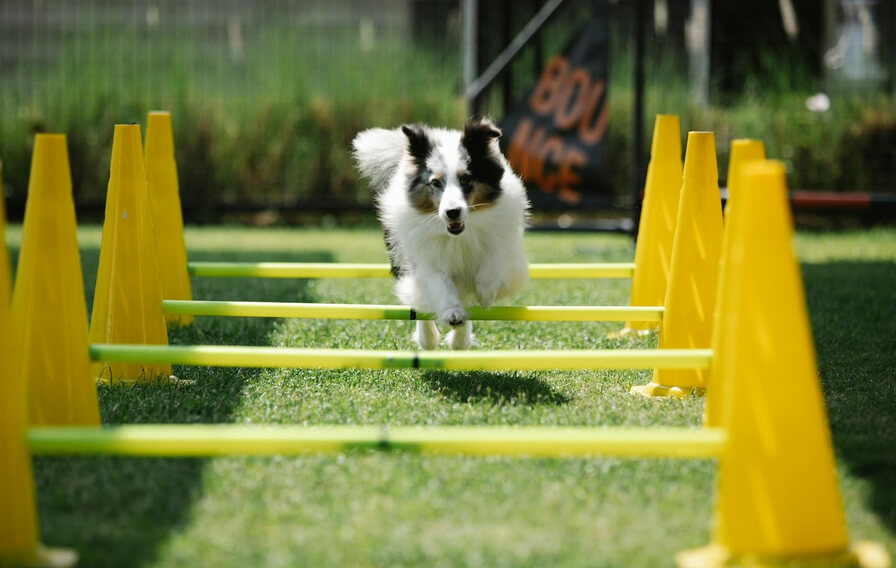
Image Source: Pexels
Creating a simple obstacle course at home is an enjoyable way to introduce your puppy to various physical challenges, enhancing their agility and confidence. Here’s a guide to get started:
- Use Household Items: Chairs, blankets, and brooms can create tunnels, jumps, and weave poles. Be creative, but ensure all setups are stable and safe for your puppy.
- Introduce One Obstacle at a Time: Start with a simple obstacle. Encourage your puppy to explore it with treats and praise. Once they’re comfortable, gradually introduce more complex elements.
- Keep It Positive: The experience should always be fun and rewarding. Never force your puppy to navigate an obstacle they’re uncomfortable with.
- Vary the Course: Regularly change the course’s layout or challenges to keep it exciting and challenging for your puppy.
- Incorporate Training Commands: Use obstacle courses as an opportunity to practice commands like “sit,” “stay,” “come,” or “jump.” This improves their physical agility, obedience, and understanding of commands.
Conclusion
Integrating simple yet impactful strategies into your daily routine ensures your puppy’s developmental journey is filled with positive experiences. Remember, the path to a confident adult dog is paved with patience, consistency, and a dash of creativity. Embrace this special time to forge a deep, enduring bond with your puppy, setting the stage for a lifetime of mutual understanding and affection.
While engaging in DIY puppy socialization activities in San Jose’s dog-friendly environment can significantly benefit your puppy’s development, consulting a professional for puppy socialization training can offer structured guidance and ensure your puppy receives comprehensive social exposure. Professionals can address specific behavioral needs, ensure interactions are safely managed, and provide personalized advice for your puppy’s growth.
Combining home-based initiatives with expert input, this dual approach sets a solid foundation for your puppy’s social skills and behavioral health.
If you want to give your puppy the best start in life with professional guidance, consider enrolling in our specialized puppy socialization program at D for Dog Training. Our expert trainers are dedicated to helping your puppy navigate the complexities of the social world, ensuring they grow up to be confident, well-adjusted dogs. Join our community of responsible pet owners in the Bay Area and set your puppy on the path to success.
About the Author: Kaajal Tiwary
Kaajal (aka “KT”!) loves puppies and is dedicated to getting new puppy guardians off on the right paw and guiding her students through the tough early days of owning a dog. Her goal? Transforming each bundle of raw puppy energy into the perfect adult companion.
